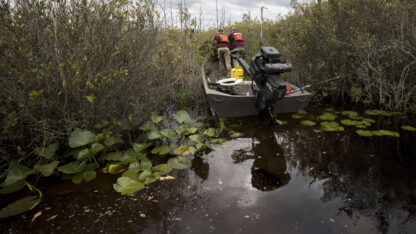The National Park Service is proposing the Okefenokee National Wildlife Refuge to become a United Nations Educational, Scientific and Cultural Organization (UNESCO) World Heritage Site.
The United States can only nominate one location each year for the United Nations honor, and the National Park System (NPS) ultimately selects the singular nominee from a list of proposed options, including National Parks and historic and cultural sites that meet at least one of the organization’s 10 criteria.
“Should (NPS) ultimately move forward and submit the nomination, it will be the first unit in the National Wildlife Refuge System that is in fact, nominated,” said Christian Hunt, Senior Federal Lands Policy Analyst for conservation organization Defenders of Wildlife.
The nomination comes after a slate of environmental groups and government officials — such as Sen. Jon Ossoff and Rep. Buddy Carter (R-Savannah) — have thrown their support behind the continent’s largest blackwater swamp.
The Okefenokee Swamp, which is in large part encompassed by the Okefenokee National Wildlife Refuge, is the continent’s largest blackwater swamp: a nutrient-rich, slow-flowing and forested wetland to which the Muscogee Nation has deep cultural ties. Home to animals like alligators and black bears, among thousands of other species, the 400,000 acres of wetland space is unique for its biodiversity, peatlands and carbon-storing abilities and acts as the headwaters to the St. Marys and Suwannee rivers.
“The national wildlife refuges have similar conservation mandates, but the refuge system is the only system of public lands in the country that are managed first and foremost for wildlife,” Hunt said.
Threat galvanizes support
The Okefenokee Swamp was first put up for the U.N. honor in 1982, but has never made the list. Although this nomination has been a long time coming for many environmentalists, it’s also arriving after years of heightened attention at the swamp due to a controversial proposed mining project. The Georgia Environmental Protection Division is currently considering permitting a titanium dioxide mining operation
The U.N. designation wouldn’t provide legal protection against a controversial proposed mining project. Alabama-based Twin Pines Minerals is seeking permits to operate a titanium dioxide mine just outside the National Wildlife Refuge, which opponents from environmentalists to scientists argue will severely damage the swamp ecosystem.
“The threat of the mine certainly brought us all to the table with the level of urgency to really come to understand and know this place and what potentially could be lost,” said Ben Prater, Southeast Program Director at Defenders of Wildlife, but he emphasized the work to recognize the swamp has been going on much longer than and often independently of the proposed mine.
“The World Heritage designation is a product of and recognition of the special nature of this place and provides an opportunity to name that place on the map at the global scale to bring it the level of awareness it needs long-term into the future,” Prater said.
The next step for the World Heritage Site list nomination process is for the U.S. Fish and Wildlife Service to prepare a nomination packet detailing the swamp’s merits and how it meets the U.N.’s criteria for the important landmark designation. According to Prater, this process could take a year to a few years before a final decision is made.









